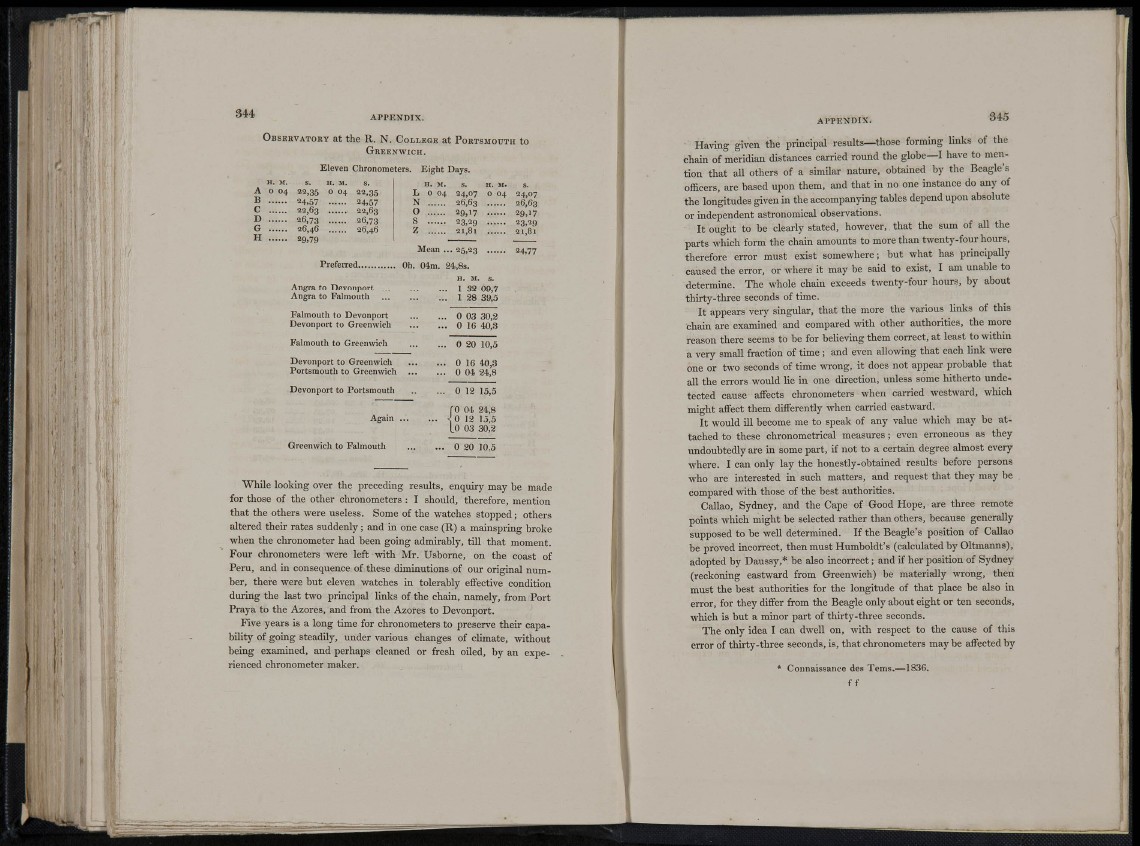
i ; ••íi.
•1:!! I''ill
;í üi,!.
34.4. APPENDIX.
O B S E R V A T O H Y a t t h e R , N . COLLEGE a t POBTSMOUTH to
G R E E N W I C H .
Eleven Chronometers. Eight Days.
H. M. S. H. M. s .
A 0 04 2 2 , 3 5 0 04 2 2 , 3 5
B 2 4 , 5 7 2 4 , 5 7
C 2 2 , 6 3 2 2 , 6 3
D 2 6 , 7 3 2 6 , 7 3
G 2 6 , 4 6 2 6 , 4 6
2 9 , 7 9
H. M. S. H. M.
L 0 04 24,07 o 04
N 28 , 6 3
O 29 , 1 7
S 23 , 2 9
Z 21.81
M e a n ... 25,23
Preferred Oh. 01m. 24,,8s.
24,07
2 6 , 6 3
29,17
2 1 , 8 1
2 4 , 7 7
Angra to Devoiiport ...
Angra to Falmouth ...
Falmouth to Devonport
Devonport to Greenwich
Falmoutli to Greenwich
Devonport to Greenwich
Portsmouth to Greenwich
Devonport to Portsmouth
Again ..'.
Greenwich to Falmouth
H. M. s.
... 1 32 09,7
... 1 28 3S),S
... 0 03 30,2
... 0 16 40,3
... 0 20 10,5
... 0 16 40,3
... 0 04 24,8
... 0 12 15,5
0 04 24,8
0 12 lj,5
.0 03 30,2
0 20 10,5
While looking over the preceding results, enquiry may he made
for those of the other chronometers : I should, therefore, mention
that the others were useless. Some of the watches stopped; others
altered their rates suddenly; and in one case (R) a mainsprmg broke
when the chronometer had been going admirably, tiU that moment.
Four chronometers were left with Mr. Usborne, on the coast of
Peru, and in consequence of these diminutions of our original number,
there were but eleven watches in tolerably effective condition
durmg the last two principal links of the chain, namely, from Port
Praya to the Azores, and from the Azores to Devonport.
Five years is a long time for chronometers to preserve their capability
of going steadily, under various changes of climate, without
being examined, and perhaps cleaned or fresh oiled, by an experienced
chronometer maker.
A P P E N D I X . 34.5
Having given the principal results—those forming links of the
chain of meridian distances carried round the globe—1 have to mention
that all others of a similar nature, obtained by the Beagle's
officers, are based upon them, and that in no one instance do any of
the longitudes given in the accompanying tables depend upon absolute
or independent astronomical observations.
It ought to be clearly stated, however, that the sum of all the
parts which form the chain amounts to more than twenty-four hours,
therefore en-or must exist somewhere; but what has principally
caused the error, or where it may be said to exist, I am unable to
determine. The whole chain exceeds twenty-four hours, by about
thirty-three seconds of time.
It appears very singular, that the more the various links of this
chain are examined and compared with other authorities, the more
reason there seems to be for beUeving them correct, at least to within
a very small fraction of time ; and even allowing that each link were
one or two seconds of time wrong, it does not appear probable that
all the errors would lie in one direction, unless some hitherto undetected
cause affects chronometers when carried westward, which
might affect them differently when carried eastward.
It would ill become me to speak of any value which may be attached
to these chronometrical measures; even erroneous as they
undoubtedly are in some part, if not to a certain degree almost every
where. I can only lay the honestly-obtained results before persons
who are interested in such matters, and request that they may be
compared with those of the best authorities.
Callao, Sydney, and the Cape of Good Hope, are three remote
points which might be selected rather than others, because generally
supposed to be well determined. If the Beagle's position of Callao
be proved incorrect, then must Humboldt's (calculated by Oltmanns),
adopted by Daussy,* be also incorrect; and if her position of Sydney
(reckoning eastward from Greenwich) be materially wrong, then
must the best authorities for the longitude of that place be also in
error, for they differ from the Beagle only about eight or ten seconds,
which is but a minor part of thirty-three seconds.
The only idea I can dwell on, with respect to the cause of this
error of thirty-three seconds, is, that chronometers may be affected by
* Connaissance des Terns.—1836.
f f